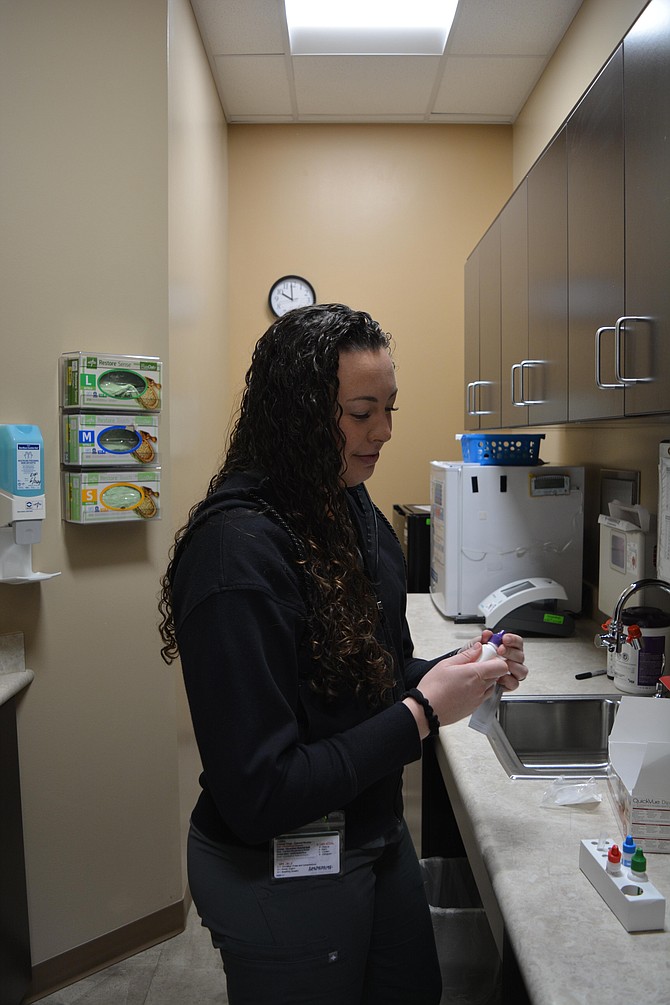Tackling challenges in rural health care

Rylee Chambers pulls out materials to process a strep test at Shoshone Medical Center's clinic in Smelterville.
When it comes to rural health care, cross-agency collaboration is often needed to find creative solutions to ensure that barriers to care are removed.
Paul Lewis, CEO of Shoshone Medical Center, said often people don’t realize how many workers are needed to pull together all the moving parts that make up a hospital system. He said that while nurses and clinical doctors are the face of the medical profession, individuals working within the health care system know the importance of IT professionals and other technicians in making day-to-day operations run smoothly.
“We follow the same safety and quality and regulatory requirements as the large urban hospitals, and so we have a lot of responsibility to maintain those standards with fewer people. We all wear a lot of hats and we’re all very busy, but that’s part of rural health care,” Lewis said.
Keeping standards of care with fewer resources
Lewis said he anticipates staffing challenges will be an issue when it comes to meeting the needs of rural communities in Shoshone County and beyond.
“I think probably for most rural health care providers throughout the United States, it’s always a challenge to have the staff and availability for staff. We run 24/7 and keep care local in our communities and provide the level of care that’s needed,” he said.
Maintaining consistent staff levels during the pandemic led to a spike nationwide in traveling medical staff.
“It’s expensive, too, to staff that way. It’s a financial challenge to be reliant on it. We have had to use travel nurses and technologists, but I’m happy to say that right now, this last week was the first week that we’ve not had travel staff in probably a year or two,” Lewis said in mid-October.
Empowered by partnerships
Shoshone Medical Center has a 25-bed hospital at the height of its capacity, but currently, the facility strives to keep the capacity at a maximum of 11-12 beds.
Between supporting a busy emergency room and bolstering the clinic in Smelterville, Lewis estimates there are a couple thousand established patients regularly using Shoshone Medical Center annually for primary care. Grassroots connections with other medical centers help keep health care workers keyed into new resources and adaptive approaches that could be applied locally.
“We use a lot of partnerships to be able to do what we do,” Lewis said.
Shoshone Medical Center works closely with the Idaho Hospital Association to stay on top of policy and service regulations, and training is often coordinated through Idaho Bureau of Rural Health and Primary Care with the Department of Health and Welfare. Lewis said the hospital has also joined the Northwest Hospital Alliance to work on a grant alongside other northern Idaho hospitals to increase access to care across their communities.
Locally, the Shoshone County Ambulance District was formed a few years ago and has developed systems to keep care constant during transports outside the county.
“Our local EMS group is absolutely essential because they’re providing transport to the hospital, but they’re also providing transport to other tertiary care facilities, too, if surgical services or something is needed by a patient that we can't provide. They’ve done a great job over the last few years building that resource so that we’re able to take patients in a timely way to other facilities,” Lewis said.
Staff at Shoshone Medical Center triage and take care of immediate patient needs before they can be transported to Coeur d’Alene, or even Spokane or occasionally Missoula for more specialized care. For comparison, according to medical transport data from July to Sept. 2023, there were 188 patients taken to Shoshone Medical Center and 87 to Kootenai Health.
Telemedicine fills in specialist gaps
Currently, the hospital is looking to add telehealth cardio offerings and has paired with Kootenai Health and occasionally Heritage Health to expand local options.
Lewis hopes insurance companies will continue to see the boon that telehealth provides in order to keep travel stress to a minimum for patients and clinicians.
“We’re always looking at trying to get access to specialty care through telemedicine. It’s a great help to our community and that helps fill some of that gap. The key is having that telemedicine where the physicians are able to stay in their office and the patients can stay here in the community and neither of them have to drive a long distance or over a mountain pass to have that care,” Lewis said.










